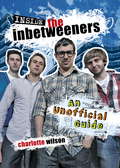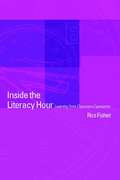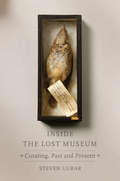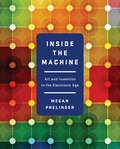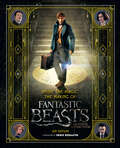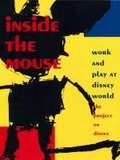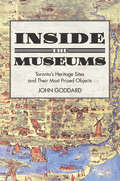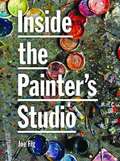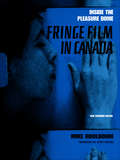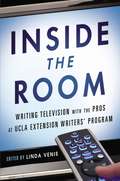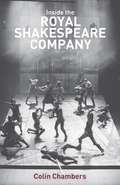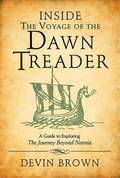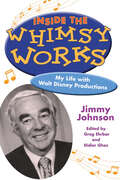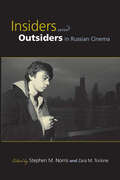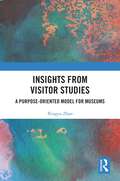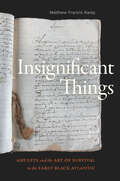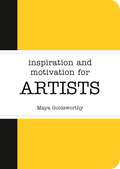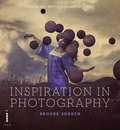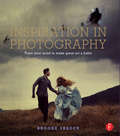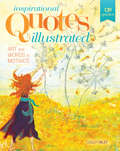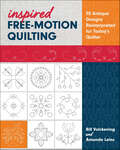- Table View
- List View
Inside the Inbetweeners: An Unofficial Full-colour Companion
by Charlotte WilsonThe Inbetweeners are Will, Simon, Neil and Jay - brought together at Rudge Park Comprehensive through their sheer lack of popularity, virginal status, and cringeworthy attempts to secure girlfriends...If you can't get enough of Will's pompous commentary, Simon's moody indecisiveness, Neil's dimwits and flatulence, or Jay's potty-mouthed boasting, then we have the very thing for you!This unique and unofficial guide brings you all the facts on the cast, both the characters and the actors behind them, comprehensive episode guides across all three series. A full listing on the music/tracks and artists featured in the show, hilarious quizzes, including Which Inbetweener Are You? and a fabulous pull-out poster of all four boys - TV's most unlikely pin-ups! Masses of colour photographs of the cast make this a must-have for teenagers of any age...
Inside the Literacy Hour: Learning from Classroom Experience
by Ros FisherThe National Literacy Strategy is at the heart of the government drive to raise the standards in literacy in schools. Based on a research project conducted in classrooms during the first year of the National Literacy Strategy (NLS), this book provides a practical analysis of the ways in which successful teachers have implemented the Literacy Hour. Taking a reflective approach, it chronicles how teachers have changed their attitudes and practice over the first year, and questions why these changes have occurred. With various descriptions of teachers' practice and examples of children's writing throughout, this is an in-depth, yet down-to-earth reflective analysis of effective literacy teaching.Ros Fisher looks in detail at issues such as; improving the teaching of literacy; researching classroom practice; children's learning in the Literacy Hour; changing practice at Key Stage One and Two and mixed age classes and literacy for four-year-olds.
Inside the Lost Museum: Curating, Past and Present
by Steven LubarMuseum lovers know that energy and mystery run through every exhibition. Steven Lubar explains work behind the scenes—collecting, preserving, displaying, and using art and artifacts in teaching, research, and community-building—through historical and contemporary examples, especially the lost but reimagined Jenks Museum at Brown University.
Inside the Machine: Art and Invention in the Electronic Age
by Megan PrelingerA visual history of the electronic age captures the collision of technology and art--and our collective visions of the future. A hidden history of the twentieth century's brilliant innovations--as seen through art and images of electronics that fed the dreams of millions. A rich historical account of electronic technology in the twentieth century, Inside the Machine journeys from the very origins of electronics, vacuum tubes, through the invention of cathode-ray tubes and transistors to the bold frontier of digital computing in the 1960s. But, as cultural historian Megan Prelinger explores here, the history of electronics in the twentieth century is not only a history of scientific discoveries carried out in laboratories across America. It is also a story shaped by a generation of artists, designers, and creative thinkers who gave imaginative form to the most elusive matter of all: electrons and their revolutionary powers. As inventors learned to channel the flow of electrons, starting revolutions in automation, bionics, and cybernetics, generations of commercial artists moved through the traditions of Futurism, Bauhaus, modernism, and conceptual art, finding ways to link art and technology as never before. A visual tour of this dynamic era, Inside the Machine traces advances and practical revolutions in automation, bionics, computer language, and even cybernetics. Nestled alongside are surprising glimpses into the inner workings of corporations that shaped the modern world: AT&T, General Electric, Lockheed Martin. While electronics may have indelibly changed our age, Inside the Machine reveals a little-known explosion of creativity in the history of electronics and the minds behind it.
Inside the Magic: The Making of Fantastic Beasts and Where to Find Them
by Ian NathanReturn to the wizarding world and discover how director David Yates and producer David Heyman brought J.K. Rowling’s all new adventure, Fantastic Beasts and Where to Find Them to the big screen.Inside the Magic: The Making of Fantastic Beasts and Where to Find Them introduces filmmaking fans to Newt Scamander, Magizoologist, and the principal characters, locations, artefacts and beasts that he encounters in 1920s New York. Explore the filmmaking magic behind MACUSA, the secretive American counterpart of the Ministry of Magic; The Blind Pig where the wizarding underworld gathers; and the magical secrets of Newt’s case.Each section contains profiles of the key characters, with revealing insights from Eddie Redmayne, Colin Farrell, Katherine Waterston, Alison Sudol, Dan Fogler and many others, together with sections on set design, costumes, make-up, special effects, art department & props (especially wands!), which are illuminated by interviews with David Heyman, David Yates, Stuart Craig, Colleen Atwood and a magical army of other crew. Packed with exciting photos that reveal the filmmaking process in discerning detail, this is the definitive adult companion book to the film, and perfect introduction to Fantastic Beasts and Where to Find Them.
Inside the Mouse: Work and Play at Disney World
by The Project on DisneyThis entertaining and playful book views Disney World as much more than the site of an ideal family vacation. Blending personal meditations, interviews, photographs, and cultural analysis, Inside the Mouse looks at Disney World's architecture and design, its consumer practices, and its use of Disney characters and themes. This book takes the reader on an alternative ride through "the happiest place on earth" while asking "What makes this forty-three-square-mile theme park the quintessential embodiment of American leisure?" Turning away from the programmed entertainment that Disney presents, the authors take a peek behind the scenes of everyday experience at Disney World. In their consideration of the park as both private corporate enterprise and public urban environment, the authors focus on questions concerning the production and consumption of leisure. Featuring over fifty photographs and interviews with workers that strip "cast members" of their cartoon costumes, this captivating work illustrates the high-pressure dynamics of the typical family vacation as well as a tour of Disney World that looks beyond the controlled facade of themed attractions. As projects like EuroDisney and the proposed Disney America test the strength of the Disney cultural monolith, Inside the Mouse provides a timely assessment of the serious business of supplying pleasure in contemporary U.S. culture. Written for the general reader interested in the many worlds of Disney, this engrossing volume will also find fans among students and scholars of cultural studies.
Inside the Museums: Toronto's Heritage Sites and their Most Prized Objects
by John GoddardHeritage Toronto Book Award — Shortlisted, Non-Fiction Book Illuminates Toronto’s early history through its small heritage museums. A portrait of William Lyon Mackenzie stares from a mural at Queen subway station, his face as round and orange as a wheel of cheese. He served as Toronto’s first mayor, led the Upper Canada Rebellion of 1837, and was grandfather to William Lyon Mackenzie King, Canada’s tenth prime minister, whose own orange-pink visage graces the Canadian fifty-dollar bill. Three blocks from the station, Mackenzie died in the upstairs bedroom of a house now open as a heritage museum, part of a network of such homes and sites from early Toronto. Inside the Museums tells their stories. It explains why Eliza Gibson risked her life to save a clock, reveals the appalling instructions that Robert Baldwin left in his will, and examines how the career of postmaster James Scott Howard shattered on the most baseless of innuendos at one of the most highly charged moments in the city’s history.
Inside the Painter's Studio
by Joe FigInside an art gallery, it is easy to forget that the paintings there are the end products of a process involving not only creative inspiration, but also plenty of physical and logistical details. It is these "cruder," more mundane aspects of a painter's daily routine that motivated Brooklyn artist Joe Fig to embark almost ten years ago on a highly unorthodox, multilayered exploration of the working life of the professional artist. Determined to ground his research in the physical world, Fig began constructing a series of diorama-like miniature reproductions of the studios of modern art's most legendary painters, such as Jackson Pollock and Willem de Kooning. A desire for firsthand references led Fig to approach contemporary artists for access to their studios. Armed with a camera and a self-made "Artist's Questionnaire," Fig began a journey through the workspaces of some of today's most exciting contemporary artists.
Inside the Pleasure Dome: Fringe Film in Canada
by Atom Egoyan Mike HoolboomEverybody loves the movies. But a movie about the colour blue, or an isolated mountain range, or a man grown so thin the world floats through his perfect transparency? 'You know what would be really great - to make a two-hour movie about Taylor Mead's ass,' remarked Andy Warhol, the most notorious fringe filmer of them all. Welcome to the strange and wonderful universe of fringe cinema, where the only rules left unbroken are the ones that have been forgotten. Twenty-three interviews with Canada's finest underdogs lay it all down like a road, ready to take you through the vanishing point of personality. This new edition includes a foreword by Atom Egoyan, and features never-before-heard raps from Ellie Epp, David Rimmer, Ann Marie Fleming, Anna Gronau, John Kneller, Rick Hancox and Kika Thorne, joining fellow fringers like Mike Snow, Carl Brown, Patricia Gruben, Penelope Buitenhuis, Fumiko Kiyooka, Wrik Mead, Annette Mangaard, Garine Torossian, Richard Kerr and Mike Cartmell.
Inside the Room
by Linda VenisAccomplished writers from the renowned UCLA Extension Writers' Program provide an invaluable how-to book for aspiring television writers What does it take to go from being a TV fan to a professional TV writer? Television writers whose many produced credits include The Simpsons; Mad Men; Frasier; X-Files; Battlestar Gallactica; CSI: Miami; Law and Order; and House, M.D.; take aspiring writers through the process of writing their first spec script for an on-air series, creating one-hour drama and sitcom pilots that break out from the pack, and revising their scripts to meet pro standards. They also learn how to launch and sustain a writing career and get a rare look inside the process of creating, selling, and getting a TV show made. Edited by Linda Venis, Director of the UCLA Extension Writers' Program, Inside the Room is an unmatched resource for everything readers need to know to write their way into the Writers Guild of America.
Inside the Royal Shakespeare Company: Creativity and the Institution
by Colin ChambersThis is the inside story of the Royal Shakespeare Company - a running historical critique of a major national institution and its location within British culture, as related by a writer who is uniquely placed to tell the tale. It describes what happened to a radical theatrical vision and explores British society's inability to sustain that vision. Spanning four decades and four artistic directors, Inside the Royal Shakespeare Company is a multi-layered chronicle that traces the company's history, offers investigation into its working methods, its repertoire, its people and its politics, and considers what the future holds for this bastion of high culture now in crisis. Inside the Royal Shakespeare Company is compelling reading for anyone who wishes to explore behind the scenes and consider the changing role of theatre in modern cultural life. It offers a timely analysis of the fight for creative expression within any artistic or cultural organisation, and a vital document of our times.
Inside the Spiral: The Passions of Robert Smithson
by Suzaan BoettgerAn expansive and revelatory study of Robert Smithson&’s life and the hidden influences on his iconic creations This first biography of the major American artist Robert Smithson, famous as the creator of the Spiral Jetty, deepens understanding of his art by addressing the potent forces in his life that were shrouded by his success, including his suppressed early history as a painter; his affiliation with Christianity, astrology, and alchemy; and his sexual fluidity. Integrating extensive investigation and acuity, Suzaan Boettger uncovers Smithson&’s story and, with it, symbolic meanings across the span of his painted and drawn images, sculptures, essays, and earthworks up to the Spiral Jetty and beyond, to the circumstances leading to what became his final work, Amarillo Ramp.While Smithson is widely known for his monumental earthwork at the edge of the Great Salt Lake, Inside the Spiral delves into the arc of his artistic production, recognizing it as a response to his family&’s history of loss, which prompted his birth and shaped his strange intelligence. Smithson configured his personal conflicts within painterly depictions of Christ&’s passion, the rhetoric of science fiction, imagery from occult systems, and the impersonal posture of conceptual sculpture. Aiming to achieve renown, he veiled his personal passions and transmuted his professional persona, becoming an acclaimed innovator and fierce voice in the New York art scene.Featuring copious illustrations never before published of early work that eluded Smithson&’s destruction, as well as photographs of Smithson and his wife, the noted sculptor Nancy Holt, and recollections from nearly all those who knew him throughout his life, Inside the Spiral offers unprecedented insight into the hidden impulses of one of modern art&’s most enigmatic figures. With great sensitivity to the experiences of loss and existential strife that defined his distinct artistic language, this biographical analysis provides an expanded view of Smithson&’s iconic art pilgrimage site and the experiences and works that brought him to its peculiar blood red water.
Inside the Voyage of the Dawn Treader: A Guide to Exploring the Journey beyond Narnia
by Devin BrownJoin award-winning author Devin Brown as he takes readers on a fascinating journey to the land of Narnia. Whether you’re a longtime fan of The Chronicles of Narnia or are just discovering them for the first time, you will be amazed and inspired as you undertake your very own chapter-by-chapter guided tour of C. S. Lewis’s beloved classics.This tale about Narnia takes readers on a high-seas adventure to places beyond the imagination filled with new characters and new conflicts. Learn more about Reepicheep, the valiant mouse who is small in stature but great in courage. Meet Eustace Clarence Scrubb and find out how Professor Lewis came up with his dreadful name. Travel to where sky and water meet and discover how Aslan is also present in our world as well.
Inside the Whimsy Works: My Life with Walt Disney Productions
by Jimmy JohnsonIn this never-before-published memoir from the files of The Walt Disney Archives, Disney Legend Jimmy Johnson (1917-1976) takes you from his beginnings as a studio gofer during the days of Snow White and the Seven Dwarfs to the opening of Walt Disney World Resort. Johnson relates dozens of personal anecdotes with famous celebrities, beloved artists, and, of course, Walt and Roy Disney. This book, also the story of how an empire-within-an-empire is born and nurtured, traces Johnson’s innovations in merchandising, publishing, and direct marketing, to the formation of what is now Walt Disney Records. This fascinating autobiography explains how the records helped determine the course of Disney Theme Parks, television, and film through best-selling recordings by icons such as Annette Funicello, Fess Parker, Julie Andrews, Louis Armstrong, and Leopold Stokowski and the Philadelphia Orchestra. Through Jimmy Johnson’s remarkable journey, the film, TV, and recording industries grow up together as changes in tastes and technologies shape the world, while the legacy of Disney is developed as well as carefully sustained for the generations who cherish its stories, characters, and music.
Insiders and Outsiders in Russian Cinema
by Stephen M. Norris Zara M. TorloneIdentifying who was "inside" and who was "outside" the Soviet/Russian body politic has been a matter of intense and violent urgency, especially in the high Stalinist and post-Soviet periods. It is a theme encountered prominently in film. Employing a range of interpretive methods practiced in Russian/Soviet film studies, Insiders and Outsiders in Russian Cinema highlights the varied ways that Russian and Soviet cinema constructed otherness and foreignness. While the essays explore the "us versus them" binary well known to students of Russian culture and the ways in which Russian films depicted these distinctions, the book demonstrates just how impossible maintaining this binary proved to be.Contributors are Anthony Anemone, Julian Graffy, Peter Kenez, Joan Neuberger, Stephen M. Norris, Oleg Sulkin, Yuri Tsivian, Emma Widdis, and Josephine Woll.
Insights from Visitor Studies: A purpose-oriented model for museums
by Xingyu ZhaoInsights from Visitor Studies: A purpose-oriented model for museums provides a systematic overview of the value of visitor studies and, for the first time in English, a comprehensive overview of the development of visitor studies in mainland China.This book emphasizes the importance of approaching visitor studies with a focus on purpose-oriented way and introduces the PSD model based on it. Zhao suggests that when museums aim to use the results of visitor research to gain support, or when they want to conduct a visitor evaluation to address a specific issue, they can follow the logical sequence of Purpose, Standpoint, and Dimension for analysis and identification. This approach will help museums derive maximum value from previous research or enhance the effectiveness of evaluations in practice. Throughout this process, Zhao not only consolidates literature from various cultural backgrounds into a unified framework, but also strives to incorporate existing terminology from the field of visitor studies to the greatest extent possible.Insights from Visitor Studies: A purpose-oriented model for museums examines the value of visitor studies for museum practice. It will be of great interest to museum practitioners to design transparent visitor research and evaluation practices. It will also assist academics and students engaged in the study of museums, heritage and tourism.
Insignificant Things: Amulets and the Art of Survival in the Early Black Atlantic (The Visual Arts of Africa and its Diasporas)
by Matthew Francis RareyIn Insignificant Things Matthew Francis Rarey traces the history of the African-associated amulets that enslaved and other marginalized people carried as tools of survival in the Black Atlantic world from the seventeenth to the nineteenth centuries. Often considered visually benign by white Europeans, these amulet pouches, commonly known as “mandingas,” were used across Africa, Brazil, and Portugal and contained myriad objects, from herbs and Islamic prayers to shells and coins. Drawing on Arabic-language narratives from the West African Sahel, the archives of the Portuguese Inquisition, sixteenth- and seventeenth-century European travel and merchant accounts of the West African Coast, and early nineteenth-century Brazilian police records, Rarey shows how mandingas functioned as portable archives of their makers’ experiences of enslavement, displacement, and diaspora. He presents them as examples of the visual culture of enslavement and critical to conceptualizing Black Atlantic art history. Ultimately, Rarey looks to the archives of transatlantic slavery, which were meant to erase Black life, for objects like the mandingas that were created to protect it.
Inspiration and Motivation for Artists
by Maya GoldsworthyThis colourful little book of uplifting quotes and tailored tips delivers motivational sparks and creative signposts for artists. Read it, doodle in it, turn it into an inspirational collage – whatever you do it, the aim is simple: to get you creating art!
Inspiration in Photography: Train Your Mind To Make Great Art A Habit
by Brooke ShadenAs a photographer its possible to train your mind to see the possibilities in any situation, and this book will show you how. By introducing you to her creative process, Brooke Shaden reveals techniques and exercises that will let you be inspired by your environment, everyday, and everywhere. In addition to the exercises, you'll learn how to compose, plan and shoot colourful, atmospheric, artistic photographs, and develop the confidence to adapt Shaden's techniques and apply them to your own photographic style.
Inspiration in Photography: Training your mind to make great art
by Brooke ShadenInspiration is not a far-flung concept, out of reach to all but a few great artists and nor is it a matter of chance; as a photographer it's possible to train your mind to see the creative possibilities in any situation. Featuring the pioneering work of author Brooke Shaden and a selection of carefully chosen contributing photographers, this book provides the perfect balance of insight and instruction to help you find inspiration whenever you need it and capitalise on it every time.
Inspiration in Photography: Training your mind to make great art a habit
by Brooke ShadenAs a photographer it’s possible to train your mind to see inspiration in any situation, and this book will show you how. By introducing you into her creative process, Brooke Shaden—one of the most recognized names in modern art photography—reveals techniques and exercises that you can undertake in order to be inspired by your environment, everyday, everywhere. In addition to the exercises, you’ll learn how to compose, plan and shoot colorful, atmospheric, fairy-tale artistic photography, so you can adapt Shaden’s techniques and apply them to your own photographic style. Indeed, all artistic photographers seek to achieve their own style, but it’s not always easy to see how to get there. This book provides the perfect balance of insight and instruction to help you find inspiration whenever you need it, and capitalize on it every time.
Inspirational Quotes Illustrated: Art and Words to Motivate
by Lesley Riley"Toss in a stone and begin your own ripple of influence." --Joy Cooper Featuring more than 100 artists and 130 quotes, Lesley Riley has created the ultimate book of "quotespiration." With quotes from artists, authors, philosophers and cultural icons, there are words of wisdom to speak to everyone from every walk of life. Each quote is paired with a powerful piece of art created by artists from all backgrounds to serve as creative prompts for anyone in the need of an art-making jumpstart. You'll find digital art, collage, art-journal pages, quilt art, assemblage and much more to inspire the artist in you. "When we look at art we are looking for ourselves." --Lesley Riley Find yourself in Inspirational Quotes Illustrated. Features: Perforated pages so you can tear out and frame the art and quotes that most inspire you! Art from your favorite artists, including Bridgette Guerzon Mills, Seth Apter, Mary Beth Shaw, Pam Carriker and more! 130 quotes and beautiful art to motivate artists and non-artists alike.
Inspire Your Home: Easy Affordable Ideas to Make Every Room Glamorous (Inspire Your Home)
by Farah MerhiInstagram star and founder of Inspire Me! Home Décor shares her creative and elegant interior design secrets so you can create a glamorous yet cozy home without spending a fortune. Farah Merhi launched Inspire Me! Home Decor in 2012 as a creative outlet during a transitional time in her life. Farah was about to graduate college and planned to attend law school. Going through the motions and feeling unfulfilled in her career choice, she built up the courage to face her truth. Taking time off to figure herself out, Farah, through a remodel project in her home, had her “ah-ha” moment. The importance of taking care of your home, specifically in the way you clean, organize, and design, was instilled in her at a young age, but she didn’t realize how much of an impact her upbringing had until she owned her own home. Farah knew she had found her passion and calling, and was determined to inspire home owners to live their best lives in their homes. Farah believes that taking care of your home is essential to your peace of mind. Her design style is elegant and glamorous but infused with warmth and coziness, creating a welcoming feel with neutral color palletes, soft and inviting fabrics, and exquisite design details that can work in any room. She believes you can make a statement without sacrificing an inviting feel to your rooms. There is no right and wrong when it comes to designing your home and Farah encourages you to focus on the overall look and feel you desire, and her tips and advice will help guide you through the process. Starting with her most frequently asked questions about paint color versus wallpaper, lighting and rugs, home organization, and of course styling, Farah walks you through every room in the house from the mudroom to the kitchen and kids’ bedrooms. Along the way, she includes quick seasonal updates on a budget, suggested routines for maintaining your space, and her unique reward system, which includes small styling vignettes around your home. Woven throughout are Farah’s personal stories that will feel like you’re getting design advice from a close friend. Everyone deserves to walk into a beautifully decorated home every day—now you can, with the inspiration and practical tips in Inspire Your Home.
Inspired Free-Motion Quilting: 90 Antique Designs Reinterpreted for Today’s Quilter
by Amanda Leins Bill VolckeningBorrow from history for your next quilt with ninety free-motion quilting designs reinterpreted from eighteenth- and nineteenth-century quilts. Honor the elegance of the past with collector Bill Volckening and quilter Mandy Leins, who modernizes motifs such as the orange peel, feathers, and quatrefoil into continuous-lines designs that are perfect for all of today's quilts. Plus, learn tips for marking, combining motifs, and quilting. - Something old, something new! Ninety refreshing free-motion designs inspired by antique quilts - Finish quilts like a pro with tips for selecting and combining patterns, marking quilt tops, and using rulers - Look at eighteenth- and nineteenth-century quilts in a new way with esteemed authors Bill Volckening and Amanda Leins
Inspired Ikebana: Modern Design Meets the Ancient Art of Japanese of Flower Arrangement
by Naoko ZaimaAesthetic Arrangements for the Artsy Minimalist#1 New Release in Folkcrafts, Japanese Gardens, Botany of Flowers, and Architectural PhotographyDiscover modern Ikebana, the Japanese art of floral design, to form and cultivate internal peace and creativity. You can create minimalist decor with Ikebana, otherwise known as Kado, a disciplined art form that brings together nature and the inner self through flower arrangement.Delight in the intentionally minimalist floral designs. Perfect for anyone interested in historic culture, flower arranging, Japanese art, or minimalist decorating. This beautifully-photographed instructional guide is a modern take on a centuries-old art. It's filled with simple-to-follow, step-by-step instructions that allow you to create stunning decor and learn how to make floral arrangements in various Ikebana styles using both fresh and dried flowers.The history of Kado, reimagined. Ikebana is a long-practiced, much respected artform with an intriguing history, and author Naoko Zaima is excited to share the story with you in this lovely Japanese art book and floral design book.Inside, you’ll find:Alluring simplistic design inspirations and pictures of IkebanaStories featuring the history of Ikebana and its impact on floral design through historyHow to make everything Kado—from floral bouquets to wreaths and more—accompanied by suggestions of the best flower arrangement tools to use for each projectIf you liked elevated arrangement books like Floret Farm's A Year in Flowers, Marie Kondo's Kurashi at Home, or Inspired by Nature, you’ll love Inspired Ikebana.
